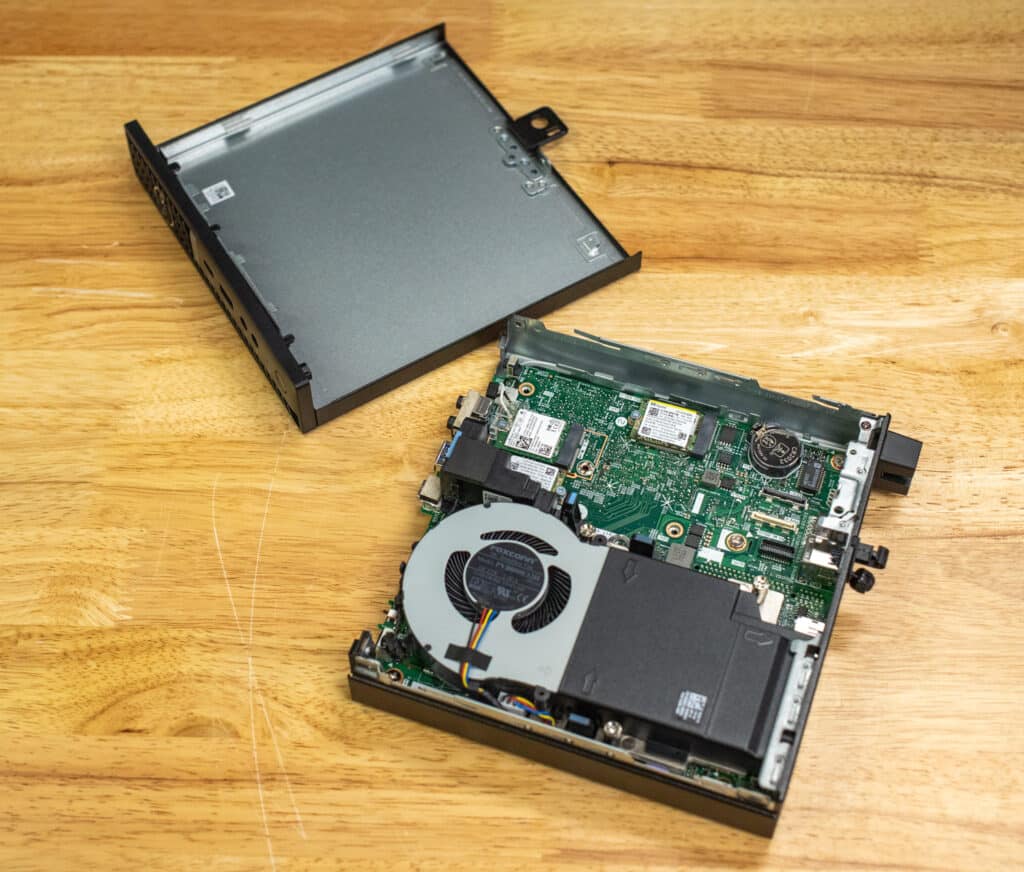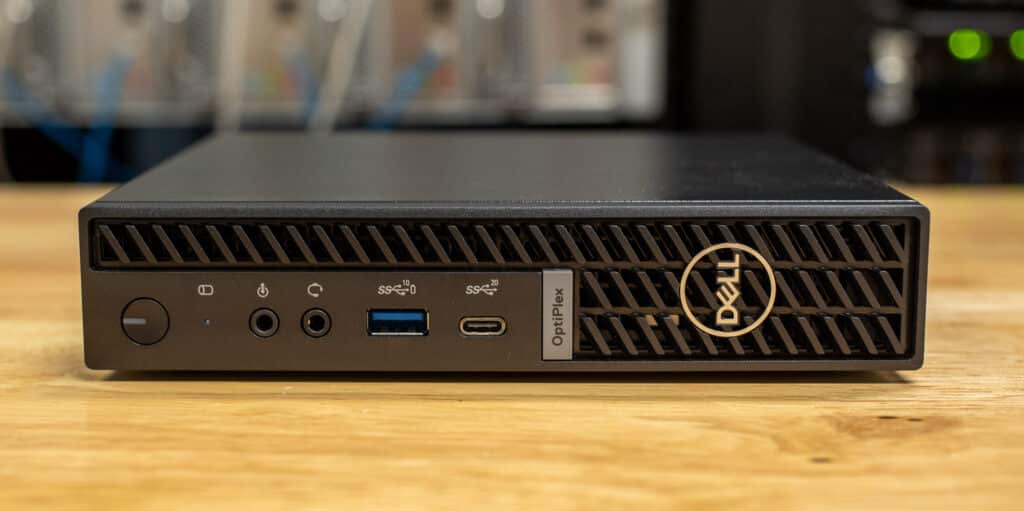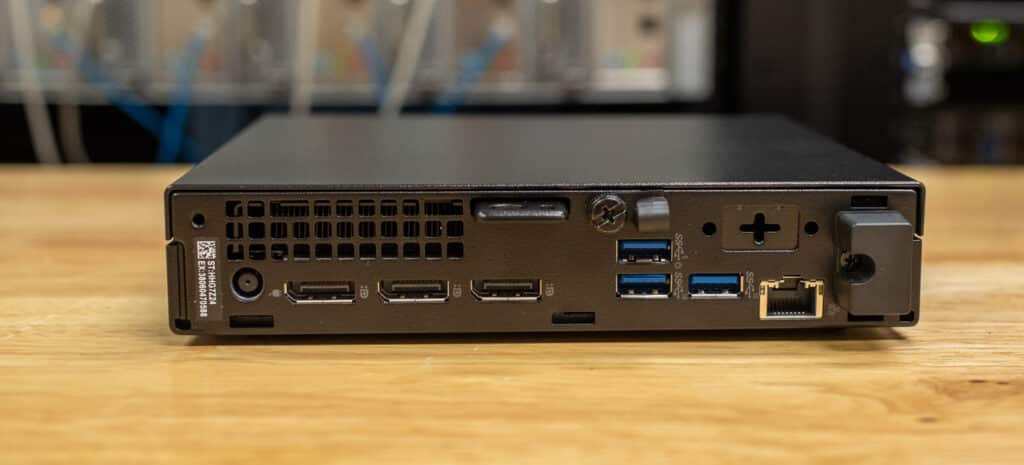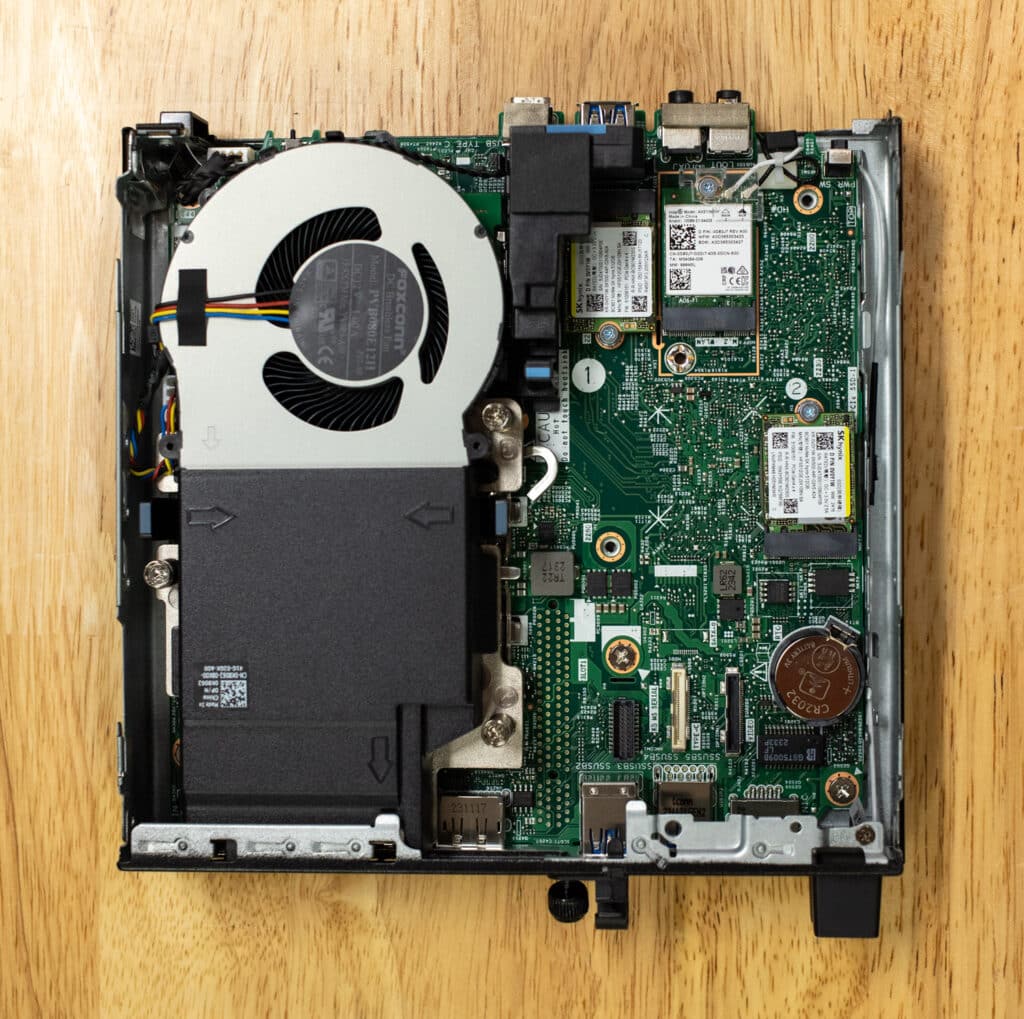The Dell OptiPlex Micro Plus 7020 offers secure data management, efficient processing, and ease of service in space-limited environments.
The Dell OptiPlex Micro Plus 7020 is a compact desktop workstation designed for business environments where space is limited. Its small form factor makes it suitable for call centers, small offices, or retail setups. With customizable hardware options, it can be configured to handle various professional tasks, from multitasking to moderate workloads, and is designed to integrate easily into different workspace setups.
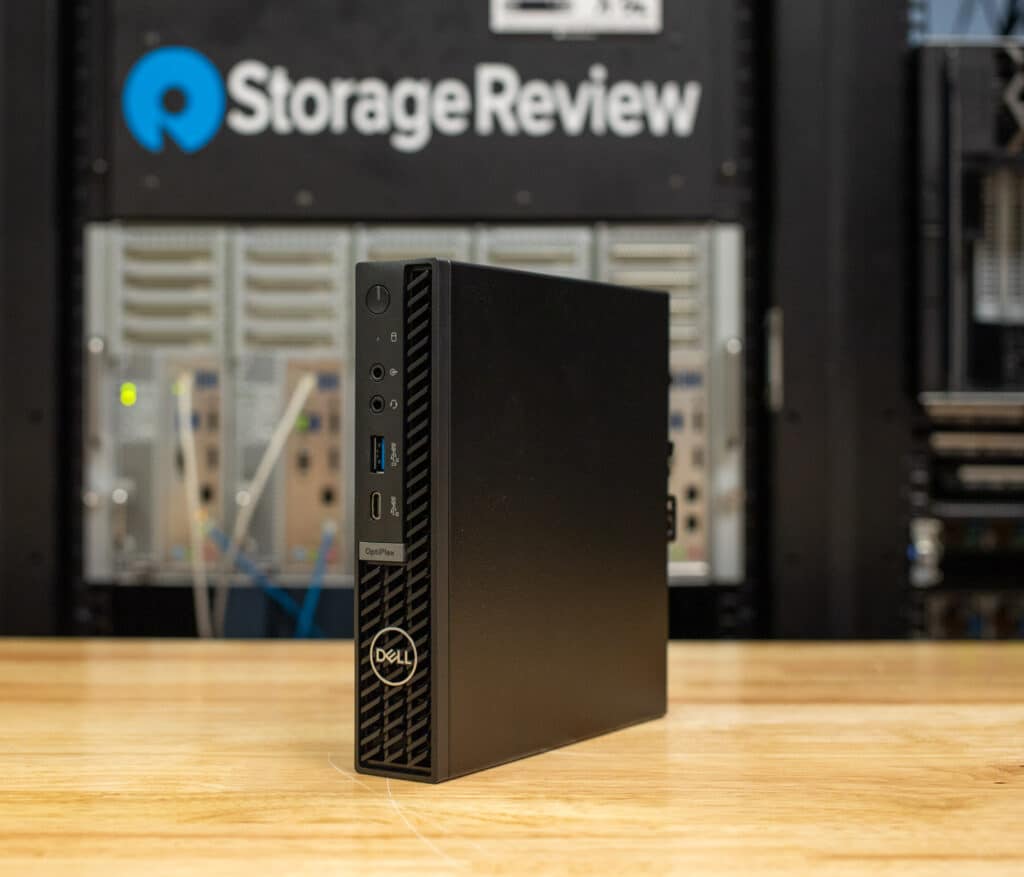
OptiPlex 7020 Micro Plus: Processors
The Dell OptiPlex Micro Plus 7020 offers a variety of processor options, making it easy for businesses to tailor performance to their specific needs. With support for Intel’s 13th Gen Core processors, it aims to balance performance and energy efficiency, from the Intel Core i3 for basic office tasks to the Core i9 for more intensive workloads. This flexibility allows businesses to choose a setup that best suits their operations.
Let’s break down the processor options:
- Intel Core i3 14100 and i3 14100T: These entry-level processors are ideal for basic tasks such as web browsing, document editing, and light multitasking. Both processors feature 4 cores and 8 threads, with turbo clock speeds of up to 4.7 GHz. These are great for businesses with minimal processing demands, offering reliable performance at lower costs.
- Intel Core i5 14500, i5 14500T, i5 14600, and i5 14600T: Available in both standard (65W) and low-power (35W) T variants, these core i5 processors provide a decent middle ground for users who require a little more power for multitasking, spreadsheet management, and database operations. With 6 performance cores, 8 efficient cores, and 20 threads, these processors can handle heavier workloads, making them a viable choice for users who regularly run multiple applications at once.
- Intel Core i7 14700 and i7 14700T: These processors offer 8 performance cores, 12 efficient cores, and 28 threads, making them better suited for more demanding environments, such as some graphic design, light video editing, or data analysis. They are also energy efficient, with turbo clock speeds reaching up to 5.4 GHz.
- Intel Core i9 14900 and i9 14900T: At the top end, the Core i9 processors are built for those who need high performance. Featuring 24 cores (8 performance cores and 16 efficient cores) and 32 threads, these processors are optimized for highly intensive multitasking and virtualization. Turbo speeds reach up to 5.6 GHz, providing decent processing power for businesses that rely on heavy computing.
Each processor is also paired with Intel UHD Graphics (UHD 730 on Core i3 models and the UHD 770 on Core i5 through i9 models), which can support up to three or four external displays, depending on your configuration.
As an integrated GPU, it’s not designed for demanding graphics work, but it’s well-suited to the workstation’s primary use cases. This GPU easily supports tasks like presentations, video conferencing, data management, and web-based applications. It is a practical choice for environments focused on productivity and multitasking without heavy graphics requirements.
OptiPlex 7020 Micro Plus: Storage and Memory
The OptiPlex 7020 also has a range of storage and memory options. It supports DDR5 memory with speeds up to 5600 MT/s, and you can configure it with up to 64GB of RAM. While that might not sound like a ton compared to more powerful workstations, it’s still plenty for handling heavy multitasking and memory-hungry applications. As for storage, you can set up the OptiPlex Micro Plus 7020 with PCIe NVMe SSDs, giving you up to 2TB of speedy storage. Plus, it supports RAID configurations if you want extra data protection.
OptiPlex 7020 Micro Plus: Design and Build
At just 182 mm tall, 36 mm wide, and 178 mm deep, it’s small enough to mount behind a monitor, under a desk, or even on a wall, which frees up valuable desk space. Despite its tiny footprint, this system packs solid performance and plenty of connectivity options, making it perfect for modern offices where space is tight. It is also VESA-compatible, making it easy to mount behind a monitor or on a wall, helping save space and reduce cable clutter. The 7020 also features a tool-less chassis design for easy maintenance or upgrades, like adding memory or swapping storage.
For connectivity, the Micro Plus 7020’s front-facing ports include a USB 3.2 Gen 2 (10 Gbps) port with PowerShare, which allows for quick device charging, even when the system is powered off. It also has a USB 3.2 Gen 2×2 Type-C (20 Gbps) port for fast data transfer, which is ideal for external storage or connecting a monitor through DisplayPort alt mode. A universal audio jack and a re-tasking line-in/line-out port also support headsets, speakers, and other audio devices, making the essential connections easily accessible.
In the back, the Micro Plus 7020 has three DisplayPort 1.4a outputs, providing connectivity for up to three 4K monitors at 60Hz, a valuable feature for multitasking across multiple displays. Two USB 3.2 Gen 2 (10 Gbps) ports provide further options for connecting peripherals at fast transfer speeds, while a USB 3.2 Gen 1 (5 Gbps) port with Smart Power On lets you power up the system using a USB-connected device like a mouse or keyboard.
For additional flexibility, the rear panel includes an optional I/O module port that can be configured with HDMI, VGA, serial, or USB Type-C, depending on your specific connectivity needs. A standard Ethernet port (RJ45) rounds out the options, supporting wired network speeds up to 1GbE for a reliable, fast connection.
The image below illustrates the OptiPlex 7020’s efficient, compact design. Its components are organized to achieve high performance within such a small footprint.
The system includes a few useful physical security features, such as a Kensington lock slot and a padlock ring, to secure it and prevent theft or tampering. It also supports chassis intrusion detection and TPM 2.0, protecting your hardware and data from unauthorized access.
Dell OptiPlex Micro Plus 7020 Specifications
| Component | Specification |
|---|---|
| Operating Systems | Windows 11 Pro, English, Brazilian Portuguese, French, Spanish |
| Memory Options |
|
| Storage Options |
|
| Processor Options |
|
| Security Solutions |
|
| Warranty & Support | 36 months standard, optional upgrades available |
| Accidental Damage Protection | None |
| Keyboard & Mouse | Dell Pro Wireless Keyboard and Mouse – KM5221W Black – US English |
| Ports | Front:
Rear:
|
| Expansion Slots |
|
| Dimensions & Weight |
|
| Wireless | Intel Wi-Fi 6E AX211, 2×2, 802.11ax, Bluetooth® 5.3, internal antenna |
| Power Supply Options |
|
OptiPlex 7020 Micro Plus Performance
We used a more moderate build of the OptiPlex 7020 for performance tests. The configuration included:
- Operating System: Windows 11 64-bit (10.0.22631)
- Processor: Intel i7-14700
- Memory: 16GB DDR5 RAM
- Storage: 1TB RAID 0 SSD
- Graphics: Intel UHD Graphics 770 (onboard)
- Resolution: 2560 x 1440 px
While this setup provides solid performance for everyday tasks, the absence of a dedicated GPU and the moderate amount of RAM limited our ability to run more intensive benchmarks, like the 7-zip compression test.
We also compared its performance against two similar systems: the ASUS NUC 14 Pro and NUC 13 Pro. The NUC 13 Pro has an Intel Core i7-1360P processor, 32GB of DDR4 3200 RAM, and a 500GB Samsung PM9A1a SSD, offering more memory for multitasking and storage needs. The ASUS NUC 14 Pro steps this up with an Intel Core Ultra 7 165H processor, 16GB of faster DDR5 5600 RAM, Intel Arc Graphics, and the same 500GB Samsung PM9A1a SSD.
SPECviewperf 2020
Our first test is SPECviewperf 2020, the worldwide standard for measuring graphics performance of professional applications under the OpenGL and Direct X application programming interfaces. The viewsets (or benchmarks) represent graphics content and behavior from actual applications without having to install the applications themselves. The newest version of this benchmark went through significant updates late last year, including new viewsets taken from traces of the latest versions of 3ds Max, Catia, Maya, and Solidworks applications. In addition, they added support within all viewsets for both 2K and 4K resolution displays.
Here, the OptiPlex 7020 achieved modest scores in engineering-focused tasks (such as Creo and Solidworks) and general modeling (Maya) compared to systems with dedicated GPUs. Its high scores in areas like Energy-03 suggest that it can handle data-heavy visualizations for applications like energy sector analysis or geospatial work, but (as noted above) it’s not optimal for demanding graphics or 3D design.
| SPECviewperf2020 Viewsets (Higher is better) | OptiPlex 7020 (Intel i7-14700, 16GB DDR5 RAM) |
| 3dsmax-07 | 7.07 |
| Catia-06 | 5.94 |
| Creo-03 | 10.05 |
| Energy-03 | 4837.19 |
| Maya-06 | 18.3 |
| Medical-03 | 0.99 |
| Snx-04 | 6.59 |
| Solidworks-05 | 6.21 |
Luxmark
Another 3D benchmark we run is LuxMark, an OpenCL GPU benchmarking utility.
In LuxMark, the OptiPlex 7020 shows some interesting results when compared with the ASUS NUC 14 Pro. On the Hallbench test, the OptiPlex trails with a score of 1,359, below the NUC’s 2,033.
In the “Food” scene, the NUC takes the lead again with a score of 789 versus the OptiPlex’s 629, indicating the NUC may be slightly more efficient for smaller or less GPU-intensive render tasks.
| Luxmark (Higher is better) | OptiPlex 7020 (Intel i7-14700, 16GB DDR5 RAM) | ASUS NUC 14 Pro (Intel Ultra 7 165H, 16GB DDR5 5600) |
| Hallbench | 1,359 | 2,033 |
| food | 629 | 789 |
UL Procyon AI Inference
UL’s Procyon estimates a workstation’s performance for professional apps. We ran the test on each system, once on the CPU and once on the GPU, with TensorRT.
In this benchmark, the OptiPlex 7020 and ASUS NUC 14 Pro show comparable performance on several tasks but differ in key areas. For example, both systems achieve identical times on the MobileNet V3 (1.33ms), suggesting parity in handling lightweight inference tasks. On heavier workloads, the OptiPlex 7020 generally takes a slight lead, as seen in DeepLab V3 (38.17ms vs. the NUC 14 Pro’s 41.74ms) and Inception V4 (36.46ms vs. 38.15ms), indicating it may be better suited for handling more complex AI inference.
Meanwhile, in the Real-ESRGAN test (simulates a super-resolution workload), the ASUS NUC 13 Pro leads at 2,587.07ms, while both the OptiPlex and NUC 14 Pro have slower times (3,714.41ms and 4,205.32ms, respectively). Interestingly, the NUC 13 Pro outperforms both in the YOLO V3 test, which means it performs better with object detection tasks.
| UL Procyon Average Inference Times (Lower is better) | OptiPlex 7020 (Intel i7-14700, 16GB DDR5 RAM) | ASUS NUC 14 Pro (Intel Ultra 7 165H, 16GB DDR5 5600) | ASUS NUC 13 Pro (Intel i7-1360P, 32GB DDR4 3200) |
| MobileNet V3 | 1.33ms | 1.33ms | 6.73ms |
| ResNet 50 | 11.98ms | 12.41ms | 11.74ms |
| Inception V4 | 36.46ms | 38.15ms | 33.46ms |
| DeepLab V3 | 38.17ms | 41.74ms | 72.88ms |
| YOLO V3 | 90.31ms | 102.86ms | 61.66ms |
| Real-ESRGAN | 3,714.41ms | 4,205.32ms | 2,587.07ms |
y-cruncher
y-cruncher is a multi-threaded and scalable program that computes Pi and other mathematical constants to trillions of digits. Since its inception in 2009, it has become a popular benchmarking and stress-testing tool for overclockers and hardware enthusiasts. The program’s ability to utilize all available CPU threads makes it an excellent test of processing power and system stability.
In y-cruncher, the OptiPlex 7020’s performance had a completion time of 28.739 seconds for calculating 1 billion digits of Pi, outperforming both the ASUS NUC 14 Pro (38.375 seconds) and the NUC 13 Pro (51.281 seconds). The OptiPlex 7020 has a noticeable processing advantage, especially in multi-threaded, CPU-intensive workloads. While slower, the NUC 14 Pro’s time is respectable, while the NUC 13 Pro trails likely due to its older processor architecture and DDR4 memory. The OptiPlex 7020 seems to be the better option for users prioritizing raw computational power in math-heavy tasks.
| y-cruncher (Total Computation time) | OptiPlex 7020 (Intel i7-14700, 16GB DDR5 RAM) | ASUS NUC 14 Pro (Intel Ultra 7 165H, 16GB DDR5 5600) | ASUS NUC 13 Pro (Intel i7-1360P, 32GB DDR4 3200) |
| 1 billion digits | 28.739 seconds | 38.375 seconds | 51.281 seconds |
Blender OptiX
Blender OptiX is an open-source 3D modeling application. The score is “samples per minute,” with higher scores being better. We examine three different versions of this benchmark.
In the most recent version, Blender 4.2, the OptiPlex 7020 demonstrates solid rendering capabilities, especially in complex scenes like “Monster,” where it reached 158.658 samples per minute, significantly surpassing both the NUC 14 Pro (105.061) and NUC 13 Pro (81.940). The OptiPlex’s scores in “Junkshop” and “Classroom” also remain competitive, reflecting solid multi-threaded performance that’s especially well-suited for 3D modeling tasks in Blender’s latest release.
| Blender 4.2 CPU Samples Per Minute (Higher is Better) | OptiPlex 7020 (Intel i7-14700, 16GB DDR5 RAM | ASUS NUC 14 Pro (Intel Ultra 7 165H, 16GB DDR5 5600) | ASUS NUC 13 Pro (Intel i7-1360P, 32GB DDR4 3200) |
| Monster | 158.658 | 105.061 | 81.940 |
| Junkshop | 89.735 | 69.350 | 49.911 |
| Classroom | 48.972 | 49.893 | 33.966 |
In Blender 4.1 and 4.0, the OptiPlex 7020 shows varying results across the three scenes. Blender 4.0 “Monster” scene reached a solid 259.385 samples per minute. Still, this figure dropped to 105.061 in Blender 4.1, a substantial decrease that likely points to the different rendering requirements in the updated version. In the “Junkshop” scene, the OptiPlex performed steadily with 83.906 samples per minute in 4.0, reducing only slightly to 69.350 in 4.1. Performance in the “Classroom” scene remains consistent, with minor shifts from 51.806 in 4.0 to 49.893 in 4.1.
| OptiPlex 7020 (Intel i7-14700, 16GB DDR5 RAM) | Blender 4.1 | Blender 4.0 |
| Monster | 105.061 | 259.385 |
| Junkshop | 69.350 | 83.906 |
| Classroom | 49.893 | 51.806 |
Geekbench 6
Geekbench 6 is a cross-platform benchmark that measures overall system performance. The Geekbench Browser allows you to compare any system to it.
Here, results show decent CPU performance for the OptiPlex 7020s, scoring 2,858 in single-core and 17,116 in multi-core tests, which are noticeably better than the ASUS NUC 14 Pro and NUC 13 Pro. The OptiPlex’s lead in multi-core, in particular, demonstrates its edge in tasks that benefit from additional threads and higher CPU throughput, making it better suited for multi-threaded applications.
However, the NUCs integrated Arc GPUs pull ahead regarding GPU performance. The 14 Pro scores a solid 33,758, while the 13 Pro scores 16,389. With its Intel UHD 770, the OptiPlex scores a much more modest 8,317.
| Geekbench 6 (Higher is better) | OptiPlex 7020 (Intel i7-14700, 16GB DDR5 RAM) | ASUS NUC 14 Pro (Intel Ultra 7 165H, 16GB DDR5 5600) | ASUS NUC 13 Pro (Intel i7-1360P, 32GB DDR4 3200) |
| CPU Single-Core | 2,858 | 2,480 | 2,617 |
| CPU Multi-Core | 17,116 | 11,959 | 11,269 |
| GPU | 8,317 (Intel UHD 770) |
33,758 (Arc GPU) | 16,389 (Arc GPU) |
Blackmagic RAW Speed Test
The Blackmagic RAW Speed Test performance benchmarking tool measures a system’s capabilities in handling video playback and editing using the Blackmagic RAW codec. It evaluates how well a system can decode and play back high-resolution video files, providing frame rates for both CPU- and GPU-based processing.
In the Blackmagic RAW Speed Test, the OptiPlex 7020 shows strong CPU decoding performance for high-resolution video playback, reaching 90 FPS for 8K footage, significantly outperforming both the ASUS NUC 14 Pro (56 FPS) and NUC 13 Pro (46 FPS).
However, the OptiPlex’s performance dips to 19 FPS for GPU-based decoding using OpenCL, well below the NUC 14 Pro’s 45 FPS and the NUC 13 Pro’s 29 FPS. Again, this difference highlights the advantage of the Arc GPUs in the NUC models for handling GPU-accelerated video playback and editing.
| Blackmagic RAW (Higher is Better) | OptiPlex 7020 (Intel i7-14700, 16GB DDR5 RAM) | ASUS NUC 14 Pro (Intel Ultra 7 165H, 16GB DDR5 5600) | ASUS NUC 13 Pro (Intel i7-1360P, 32GB DDR4 3200) |
| 8K CPU | 90 FPS | 56 FPS | 46 FPS |
| 8K OPENCL | 19 FPS | 45 FPS | 29 FPS |
Blackmagic Disk Speed Test
We ran the popular Blackmagic Disk Speed Test against the system’s primary storage drive. The OptiPlex 7020 is outfitted with two SK Hynix BC901 512GB SSDs, while the two ASUS NUCs use a 500GB Samsung PM9A1a SSD.
Here, the OptiPlex 7020 delivers strong storage performance with read speeds of 6,408.3MB/s and write speeds of 4,623.1MB/s, surpassing both the ASUS NUC 14 Pro and NUC 13 Pro in both metrics. The OptiPlex remains ahead in write performance, with a noticeable lead over the NUC 14 Pro (3,649.8 MB/s) and NUC 13 Pro (3,669.8 MB/s).
| Blackmagic DiskSpeed test (Higher is Better) | OptiPlex 7020 (Intel i7-14700, 16GB DDR5 RAM) | ASUS NUC 14 Pro (Intel Ultra 7 165H, 16GB DDR5 5600) | ASUS NUC 13 Pro (Intel i7-1360P, 32GB DDR4 3200) |
| Read | 6,408.3MB/s | 4,521.9MB/s | 4,819.9MB/s |
| Write | 4,623.1MB/s | 3,649.8MB/s | 3,669.8MB/s |
Cinebench R23
Cinebench R23 is a benchmark tool that evaluates a system’s CPU performance by rendering a complex 3D scene using the Cinema 4D engine.
The OptiPlex 7020 scored 17,723 points in multi-core performance, outpacing the ASUS NUC 14 Pro (16,655 points) and the NUC 13 Pro (12,034 points). This result highlights the OptiPlex’s better handling of multi-threaded tasks due to its Intel i7-14700 CPU. For single-core performance, the OptiPlex also leads with 2,043 points, slightly above the NUC 13 Pro (1,926 points) and NUC 14 Pro (1,800 points). For the MP ratio, the OptiPlex’s 8.67x is pretty close to the NUC 14 Pro’s 9.25x, though well ahead of the NUC 13 Pro’s 6.25x, showing that the OptiPlex scales more efficiently across cores for multi-threaded tasks.
| Cinebench R23 (Higher is better) | OptiPlex 7020 (Intel i7-14700, 16GB DDR5 RAM) | ASUS NUC 14 Pro (Intel Ultra 7 165H, 16GB DDR5 5600) | ASUS NUC 13 Pro (Intel i7-1360P, 32GB DDR4 3200) | |
| Multi-Core | 17,723 pts | 16,655 pts | 12,034 pts | |
| Single-Core | 2,043 pts | 1,800 pts | 1,926 pts | |
| MP ratio | 8.67 x | 9.25 x | 6.25 x | |
Cinebench 2024
Cinebench 2024 extends the benchmark capabilities of R23 by adding GPU performance evaluation.
The OptiPlex 7020 leads in multi-core performance with 1,007 points, surpassing the ASUS NUC 14 Pro (901 points) and the NUC 13 Pro (671 points). For single-core performance, the OptiPlex also leads at 120 points, topping the NUC 14 Pro (105 points) and the NUC 13 Pro (113 points). The MP ratio is similarly strong for the OptiPlex at 8.39x, though the NUC 14 Pro leads with 8.59x this time.
| Cinebench R24 (Higher is better) | OptiPlex 7020 (Intel i7-14700, 16GB DDR5 RAM) | ASUS NUC 14 Pro (Intel Ultra 7 165H, 16GB DDR5 5600) | ASUS NUC 13 Pro (Intel i7-1360P, 32GB DDR4 3200) |
| Multi-Core | 1,007 pts | 901 pts | 671 pts |
| Single-Core | 120 pts | 105 pts | 113 pts |
| MP Ratio | 8.39 x | 8.59 x | 5.95 x |
Conclusion
The Dell OptiPlex Micro Plus 7020 is a highly capable compact desktop. It delivers solid performance for its class and customizable options tailored for business environments where space efficiency and reliability are crucial. With Intel’s 13th Gen Core processors, ranging from entry-level i3 to high-performance i9 models, the 7020 Micro Plus provides a wide selection suitable for tasks from standard multitasking to more demanding data processing. Moreover, its compact design makes it ideal for installations in tight spaces, such as behind monitors or under desks.
Regarding performance, the OptiPlex 7020 generally outperforms the ASUS NUC 13 and NUC 14 Pro in CPU-intensive tasks. Its Intel i7-14700 configuration demonstrates solid multi-core performance, making it well-suited for applications that benefit from more processing power, such as engineering simulations and some light 3D modeling tasks. While lacking a dedicated GPU, it still holds up in benchmarks like Cinebench R23 and SPECviewperf 2020, showing respectable performance for CPU-driven professional applications.
With decent performance, reliability features like TPM 2.0, and physical security options, the Dell OptiPlex Micro Plus 7020 is a viable choice for businesses prioritizing secure data management, efficient processing, and ease of service in space-limited environments.
Engage with StorageReview
Newsletter | YouTube | Podcast iTunes/Spotify | Instagram | Twitter | TikTok | RSS Feed

